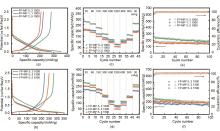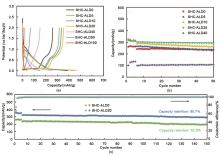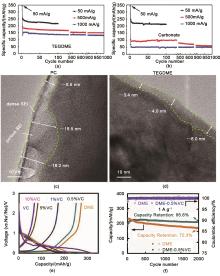Energy Storage Science and Technology ›› 2022, Vol. 11 ›› Issue (11): 3497-3509.doi: 10.19799/j.cnki.2095-4239.2022.0233
• Energy Storage Materials and Devices • Previous Articles Next Articles
Fei LIU1,2,3( ), Peiwen ZHAO1,2,3, Jingxiang ZHAO1,2,3, Xianwei SUN1,2,3, Miaomiao LI1,2,3, Jinghao WANG1,2,3, Yanxin YIN1,2,3, Zuoqiang DAI1,2,3(
), Peiwen ZHAO1,2,3, Jingxiang ZHAO1,2,3, Xianwei SUN1,2,3, Miaomiao LI1,2,3, Jinghao WANG1,2,3, Yanxin YIN1,2,3, Zuoqiang DAI1,2,3( ), Lili ZHENG1,2,3
), Lili ZHENG1,2,3
Received:2022-05-05
Revised:2022-06-08
Online:2022-11-05
Published:2022-11-09
Contact:
Zuoqiang DAI
E-mail:liufeicx0521@163.com;daizuoqiangqdu@163.com
CLC Number:
Fei LIU, Peiwen ZHAO, Jingxiang ZHAO, Xianwei SUN, Miaomiao LI, Jinghao WANG, Yanxin YIN, Zuoqiang DAI, Lili ZHENG. Research progress of hard carbon anode materials for sodium ion batteries[J]. Energy Storage Science and Technology, 2022, 11(11): 3497-3509.

Fig. 4
(a), (b) Initial galvanostatic discharge/charge profiles of all the resulting hard-soft carbon composites at 30 mA/g; (c), (d) The rate capability of all the resulting hard-soft carbon composites; (e), (f) The cycling performance of all the resulting hard-soft carbon composites at 150 mA/g[35]"


Fig. 6
(a) Initial charge-discharge profiles of hard carbon electrodes coated with different cycles of Al2O3 at a current density of 20 mA/g; (b) Cycling performance of hard carbon electrodes coated with different cycles of Al2O3 at 50 mA/g(The current rate is 20 mA/g in the initial five cycles); (c) Cycling performance of SHC-ALD0 and SHC-ALD20 at a current rate of 50 mA/g(The current rate is 20 mA/g in the initial five cycles)[37]"


Fig. 7
(a) Cycling performance of HC at different current densities in TEGDME[40]; (b) Cycling performance of HC at different current densities in carbonate[40]; (c) SEI film thickness after 1 cycle at C/3 rate in PC electrolyte by cryo-TEM imaging[41]; (d) SEI film thickness after 1 cycle at C/3 rate in TEGDME electrolyte by cryo-TEM imaging[41]; (e) Charge-discharge curves of hard carbon in different electrolytes[51]; (f) Cycling performance of hard carbon based on DME and DME-0.5%VC electrolyte at a current rate of 1A/g[51]"

| 1 | VAALMA C, BUCHHOLZ D, WEIL M, et al. A cost and resource analysis of sodium-ion batteries[J]. Nature Reviews Materials, 2018, 3: doi: 10.1038/natrevmats.2018.13. |
| 2 | LIU Y Y, MERINOV B V, GODDARD W A 3rd. Origin of low sodium capacity in graphite and generally weak substrate binding of Na and Mg among alkali and alkaline earth metals[J]. Proceedings of the National Academy of Sciences of the United States of America, 2016, 113(14): 3735-3739. |
| 3 | LI C H, SUN Y, WU Q J, et al. A novel design strategy of a practical carbon anode material from a single lignin-based surfactant source for sodium-ion batteries[J]. Chemical Communications (Cambridge, England), 2020, 56(45): 6078-6081. |
| 4 | LI Y, YUAN Y F, BAI Y, et al. Insights into the Na+ storage mechanism of phosphorus-functionalized hard carbon as ultrahigh capacity anodes[J]. Advanced Energy Materials, 2018, 8(18): doi: 10.1002/aenm.201702781. |
| 5 | STEVENS D A, DAHN J R. High capacity anode materials for rechargeable sodium-ion batteries[J]. Journal of the Electrochemical Society, 2000, 147(4): 1271. |
| 6 | STEVENS D A, DAHN J R. The mechanisms of lithium and sodium insertion in carbon materials[J]. Journal of the Electrochemical Society, 2001, 148(8): doi: 10.1149/1.1379565. |
| 7 | ILIC I K, SCHUTJAJEW K, ZHANG W Y, et al. Changes of porosity of hard carbons during mechanical treatment and the relevance for sodium-ion anodes[J]. Carbon, 2022, 186: 55-63. |
| 8 | QIU S, XIAO L F, SUSHKO M L, et al. Manipulating adsorption-insertion mechanisms in nanostructured carbon materials for high-efficiency sodium ion storage[J]. Advanced Energy Materials, 2017, 7(17): doi: 10.1002/aenm.201700403. |
| 9 | CAO Y L, XIAO L F, SUSHKO M L, et al. Sodium ion insertion in hollow carbon nanowires for battery applications[J]. Nano Letters, 2012, 12(7): 3783-3787. |
| 10 | 金前争. 硬碳电极储钠机理与构效关系研究[D]. 武汉: 华中科技大学, 2020. |
| JIN Q Z. The study on sodium storage mechanisms and structure-activity relationships of hard carbon electrode[D]. Wuhan: Huazhong University of Science and Technology, 2020. | |
| 11 | WANG K, XU Y B, LI Y, et al. Sodium storage in hard carbon with curved graphene platelets as the basic structural units[J]. Journal of Materials Chemistry A, 2019, 7(7): 3327-3335. |
| 12 | ALVIN S, CAHYADI H S, HWANG J, et al. Revealing the intercalation mechanisms of lithium, sodium, and potassium in hard carbon[J]. Advanced Energy Materials, 2020, 10(20): doi: 10.1002/aenm.202000283. |
| 13 | CHEN X Y, FANG Y L, TIAN J Y, et al. Electrochemical insight into the sodium-ion storage mechanism on a hard carbon anode[J]. ACS Applied Materials & Interfaces, 2021, 13(16): 18914-18922. |
| 14 | AU H, ALPTEKIN H, JENSEN A C S, et al. A revised mechanistic model for sodium insertion in hard carbons[J]. Energy & Environmental Science, 2020, 13(10): 3469-3479. |
| 15 | CAI C C, CHEN Y A, HU P, et al. Regulating the interlayer spacings of hard carbon nanofibers enables enhanced pore filling sodium storage[J]. Small, 2022, 18(6): doi: 10.1002/smll.202105303. |
| 16 | CHEN X Y, TIAN J Y, LI P, et al. An overall understanding of sodium storage behaviors in hard carbons by an "adsorption-intercalation/filling" hybrid mechanism[J]. Advanced Energy Materials, 2022, 12(24): doi: 10.1002/aenm.202200886. |
| 17 | JIANG N, CHEN L, JIANG H, et al. Introducing the solvent co-intercalation mechanism for hard carbon with ultrafast sodium storage[J]. Small, 2022, 18(15): doi: 10.1002/smll.202108092. |
| 18 | ESCHER I, A FERRERO G, GOKTAS M, et al. In situ (operando) electrochemical dilatometry as a method to distinguish charge storage mechanisms and metal plating processes for sodium and lithium ions in hard carbon battery electrodes[J]. Advanced Materials Interfaces, 2022, 9(8): doi: 10.1002/admi.202100596. |
| 19 | CHEN J, HU T, ZOU Z, et al. Pre-doping iodine to restrain formation of low-active graphitic-N in hard carbon for significantly boosting sodium storage performance[J]. Carbon, 2022, 186: 193-204. |
| 20 | SENTHIL C, PARK J W, SHAJI N, et al. Biomass seaweed-derived nitrogen self-doped porous carbon anodes for sodium-ion batteries: Insights into the structure and electrochemical activity[J]. Journal of Energy Chemistry, 2022, 64: 286-295. |
| 21 | SUN Y, WU Q J, WANG Y D, et al. Protein-derived 3D amorphous carbon with N, O doping as high rate and long lifespan anode for potassium ion batteries[J]. Journal of Power Sources, 2021, 512: doi: 10.1016/j.jpowsour.2021.230530. |
| 22 | PEI Z X, MENG Q Q, WEI L, et al. Toward efficient and high rate sodium-ion storage: A new insight from dopant-defect interplay in textured carbon anode materials[J]. Energy Storage Materials, 2020, 28: 55-63. |
| 23 | FAN L L, ZHANG X, FAN L P, et al. Boosting the high capacitance-controlled capacity of hard carbon by using surface oxygen functional groups for fast and stable sodium storage[J]. ACS Applied Energy Materials, 2021, 4(10): 11436-11446. |
| 24 | XING C, YANG D H, ZHANG Y, et al. Semi-closed synthesis of nitrogen and oxygen Co-doped mesoporous carbon for selective aqueous oxidation[J]. Green Energy & Environment, 2022, 7(1): 43-52. |
| 25 | CHEN C, HUANG Y, MENG Z Y, et al. Experimental design and theoretical evaluation of nitrogen and phosphorus dual-doped hierarchical porous carbon for high-performance sodium-ion storage[J]. Journal of Materials Science & Technology, 2021, 76: 11-19. |
| 26 | XIE F, NIU Y S, ZHANG Q Q, et al. Screening heteroatom configurations for reversible sloping capacity promises high-power Na-ion batteries[J]. Angewandte Chemie International Edition, 2022, 61(11): doi: 10.1002/anie.202116394. |
| 27 | WU Z R, ZOU J, ZHANG Y, et al. Lignin-derived hard carbon anode for potassium-ion batteries: Interplay among lignin molecular weight, material structures, and storage mechanisms[J]. Chemical Engineering Journal, 2022, 427: doi: 10.1016/j.cej.2021.131547. |
| 28 | VELDEVI T, RAGHU S, KALAIVANI R A, et al. Waste tire derived carbon as potential anode for lithium-ion batteries[J]. Chemosphere, 2022, 288: doi: 10.1016/j.chemosphere.2021.132438. |
| 29 | YIN X P, ZHAO Y F, WANG X, et al. Modulating the graphitic domains of hard carbons derived from mixed pitch and resin to achieve high rate and stable sodium storage[J]. Small, 2022, 18(5): doi: 10.1002/smll.202105568. |
| 30 | TONNOIR H, HUO D, CANEVESI R L S, et al. Tannin-based hard carbons as high-performance anode materials for sodium-ion batteries[J]. Materials Today Chemistry, 2022, 23: doi: 10.1016/j.mtchem.2021.100614. |
| 31 | LI Y Q, LU Y X, MENG Q S, et al. Regulating pore structure of hierarchical porous waste cork-derived hard carbon anode for enhanced Na storage performance[J]. Advanced Energy Materials, 2019, 9(48): doi: 10.1002/aenm.201902852. |
| 32 | LI Y M, WU F F, XIONG S L. Embedding ZnSe nanoparticles in a porous nitrogen-doped carbon framework for efficient sodium storage[J]. Electrochimica Acta, 2019, 296: 582-589. |
| 33 | YOUN Y, GAO B, KAMIYAMA A, et al. Nanometer-size Na cluster formation in micropore of hard carbon as origin of higher-capacity Na-ion battery[J]. Npj Computational Materials, 2021, 7: 48. |
| 34 | KAMIYAMA A, KUBOTA K, IGARASHI D, et al. MgO-template synthesis of extremely high capacity hard carbon for Na-ion battery[J]. Angewandte Chemie, 2021, 133(10): 5174-5180. |
| 35 | XIE F, XU Z, JENSEN A C S, et al. Hard-soft carbon composite anodes with synergistic sodium storage performance[J]. Advanced Functional Materials, 2019, 29(24): doi: 10.1002/adfm.201901072. |
| 36 | HE X X, ZHAO J H, LAI W H, et al. Soft-carbon-coated, free-standing, low-defect, hard-carbon anode to achieve a 94% initial coulombic efficiency for sodium-ion batteries[J]. ACS Applied Materials & Interfaces, 2021, 13(37): 44358-44368. |
| 37 | LU H Y, CHEN X Y, JIA Y L, et al. Engineering Al2O3 atomic layer deposition: Enhanced hard carbon-electrolyte interface towards practical sodium ion batteries[J]. Nano Energy, 2019, 64: doi: 10.1016/j.nanoen.2019.103903. |
| 38 | WANG C C, SU W L. Ultrathin artificial solid electrolyte interface layer-coated biomass-derived hard carbon as an anode for sodium-ion batteries[J]. ACS Applied Energy Materials, 2022, 5(1): 1052-1064. |
| 39 | SEH Z W, SUN J, SUN Y M, et al. A highly reversible room-temperature sodium metal anode[J]. ACS Central Science, 2015, 1(8): 449-455. |
| 40 | XIAO B W, SOTO F A, GU M, et al. Lithium-pretreated hard carbon as high-performance sodium-ion battery anodes[J]. Advanced Energy Materials, 2018, 8(24): doi: 10.1002/aenm.201801441. |
| 41 | HIRSH H S, SAYAHPOUR B, SHEN A, et al. Role of electrolyte in stabilizing hard carbon as an anode for rechargeable sodium-ion batteries with long cycle life[J]. Energy Storage Materials, 2021, 42: 78-87. |
| 42 | DONG R Q, ZHENG L M, BAI Y, et al. Elucidating the mechanism of fast Na storage kinetics in ether electrolytes for hard carbon anodes[J]. Advanced Materials, 2021, 33(36): doi: 10.1002/adma.202008810. |
| 43 | LI Y W, CHEN S M, XU S Y, et al. Impact of electrolyte salts on Na storage performance for high-surface-area carbon anodes[J]. ACS Applied Materials & Interfaces, 2021, 13(41): 48745-48752. |
| 44 | ZHANG J, WANG D W, LV W, et al. Achieving superb sodium storage performance on carbon anodes through an ether-derived solid electrolyte interphase [J]. Energy Environ Sci, 2017, 10(1): 370-376. |
| 45 | CHEN Y, ZHAO S, YU Y Y, et al. A general synthesis of mesoporous hollow carbon spheres with extraordinary sodium storage kinetics by engineering solvation structure[J]. Small, 2022, 18(10): doi: 10.1002/smll.202106513. |
| 46 | HU Y S, LU Y X. The mystery of electrolyte concentration: From superhigh to ultralow[J]. ACS Energy Letters, 2020, 5(11): 3633-3636. |
| 47 | JIN Y, XU Y B, LE P M L, et al. Highly reversible sodium ion batteries enabled by stable electrolyte-electrode interphases[J]. ACS Energy Letters, 2020, 5(10): 3212-3220. |
| 48 | LI Y Q, YANG Y, LU Y X, et al. Ultralow-concentration electrolyte for Na-ion batteries[J]. ACS Energy Letters, 2020, 5(4): 1156-1158. |
| 49 | FONDARD J, IRISARRI E, COURRÈGES C, et al. SEI composition on hard carbon in Na-ion batteries after long cycling: Influence of salts (NaPF6, NaTFSI) and additives (FEC, DMCF)[J]. Journal of the Electrochemical Society, 2020, 167(7): doi: 10.1149/1945-7111/ab75fd. |
| 50 | YOON S U, KIM H, JIN H J, et al. Effects of fluoroethylene carbonate-induced solid-electrolyte-interface layers on carbon-based anode materials for potassium ion batteries[J]. Applied Surface Science, 2021, 547: doi: 10.1016/j.apsusc.2021.149193. |
| 51 | BAI P X, HAN X P, HE Y W, et al. Solid electrolyte interphase manipulation towards highly stable hard carbon anodes for sodium ion batteries[J]. Energy Storage Materials, 2020, 25: 324-333. |
| [1] | Shuya GONG, Yue WANG, Meng LI, Jingyi QIU, Hong WANG, Yuehua WEN, Bin XU. Research progress on TiNb2O7 anodes for lithium-ion batteries [J]. Energy Storage Science and Technology, 2022, 11(9): 2921-2932. |
| [2] | Jing ZHU, Yida WU, Junfeng HAO, Guanjun CEN, Ronghan QIAO, Xiaoyu SHEN, Mengyu TIAN, Hongxiang JI, Zhou JIN, Yuanjie ZHAN, Yong YAN, Liubin BEN, Hailong YU, Yanyan LIU, Xuejie HUANG. Reviews of selected 100 recent papers for lithium batteries (Jun. 1, 2022 to Jul. 31, 2022) [J]. Energy Storage Science and Technology, 2022, 11(9): 3035-3050. |
| [3] | Xiaoyu SHEN, Guanjun CEN, Ronghan QIAO, Jing ZHU, Hongxiang JI, Mengyu TIAN, Zhou JIN, Yong YAN, Yida WU, Yuanjie ZHAN, Hailong YU, Liubin BEN, Yanyan LIU, Xuejie HUANG. Reviews of selected 100 recent papers for lithium batteries (Apr. 1, 2022 to May 31, 2022) [J]. Energy Storage Science and Technology, 2022, 11(7): 2007-2022. |
| [4] | Xiongwen XU, Yang NIE, Jian TU, Zheng XU, Jian XIE, Xinbing ZHAO. Abuse performance of pouch-type Na-ion batteries based on Prussian blue cathode [J]. Energy Storage Science and Technology, 2022, 11(7): 2030-2039. |
| [5] | Ronghan QIAO, Guanjun CEN, Xiaoyu SHEN, Mengyu TIAN, Hongxiang JI, Feng TIAN, Wenbin QI, Zhou JIN, Yida WU, Yuanjie ZHAN, Yong YAN, Liubin BEN, Hailong YU, Yanyan LIU, Xuejie HUANG. Reviews of selected 100 recent papers for lithium batteries (Feb. 1, 2022 to Mar. 31, 2022) [J]. Energy Storage Science and Technology, 2022, 11(5): 1289-1304. |
| [6] | Honghui WANG, Zeqin WU, Deren CHU. Thermal behavior of lithium titanate based Li ion batteries under slight over-discharging condition [J]. Energy Storage Science and Technology, 2022, 11(5): 1305-1313. |
| [7] | Haiyan HU, Shulei CHOU, Yao XIAO. Layered oxide cathode materials based on molecular orbital hybridization for high voltage sodium-ion batteries [J]. Energy Storage Science and Technology, 2022, 11(4): 1093-1102. |
| [8] | Qiannan LIU, Weiping HU, Zhe HU. Research progress of phosphorus-based anode materials for sodium-ion batteries [J]. Energy Storage Science and Technology, 2022, 11(4): 1201-1210. |
| [9] | Zhiqiang ZHAO, Hengjun LIU, Xixiang XU, Yuanyuan PAN, Qinghao LI, Hongsen LI, Han HU, Qiang LI. Magnetometry technique in energy storage science [J]. Energy Storage Science and Technology, 2022, 11(3): 818-833. |
| [10] | Guanjun CEN, Jing ZHU, Ronghan QIAO, Xiaoyu SHEN, Hongxiang JI, Mengyu TIAN, Feng TIAN, Zhou JIN, Yong YAN, Yida WU, Yuanjie ZHAN, Hailong YU, Liubin BEN, Yanyan LIU, Xuejie HUANG. Reviews of selected 100 recent papers for lithium batteries (Dec. 1, 2021 to Jan. 31, 2022) [J]. Energy Storage Science and Technology, 2022, 11(3): 1077-1092. |
| [11] | Hongxiang JI, Yida WU, Zhou JIN, Mengyu TIAN, Junfeng HAO, Yuanjie ZHAN, Yong YAN, Guanjun CEN, Ronghan QIAO, Xiaoyu SHEN, Jing ZHU, Liubin BEN, Hailong YU, Yanyan LIU, Xuejie HUANG. Reviews of selected 100 recent papers for lithium batteries (Aug. 1, 2022 to Sept. 30, 2022) [J]. Energy Storage Science and Technology, 2022, 11(11): 3423-3438. |
| [12] | Weixiang CHENG, Xingwen HUANG, Yuezhu LI, Junqi HU, Songyi LIAO, Yonggang MIN. Advances in layered metal disulfide as anode material for Na-ion batteries [J]. Energy Storage Science and Technology, 2022, 11(10): 3062-3075. |
| [13] | Mengyu TIAN, Jing ZHU, Guanjun CEN, Ronghan QIAO, Xiaoyu SHEN, Hongxiang JI, Feng TIAN, Zhou JIN, Yong YAN, Yida WU, Yuanjie ZHAN, Hailong YU, Liubin BEN, Yanyan LIU, Xuejie HUANG. Reviews of selected 100 recent papers for lithium batteries(Oct. 1, 2021 to Nov. 30, 2021) [J]. Energy Storage Science and Technology, 2022, 11(1): 297-312. |
| [14] | Penghui LI, Caiwen WU, Jianpeng REN, Wenjuan WU. Research progress of lignin as electrode materials for lithium-ion batteries [J]. Energy Storage Science and Technology, 2022, 11(1): 66-77. |
| [15] | Tingting HAN, Yuxi WU, Ziheng XIE, Xiuxia MENG, Jinjin ZHANG, Yujiao XIE, Fangyong YU, Naitao YANG. Recent advances in carbon deposition mechanism and performance improvement of Ni-based anode for solid oxide fuel cells [J]. Energy Storage Science and Technology, 2021, 10(6): 1931-1942. |
| Viewed | ||||||
|
Full text |
|
|||||
|
Abstract |
|
|||||
